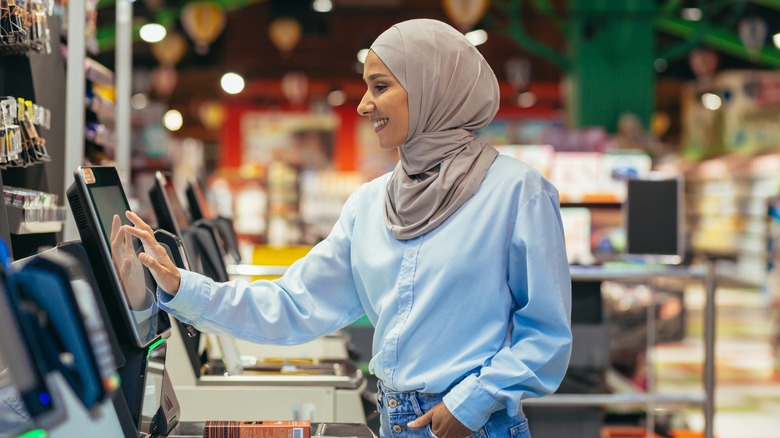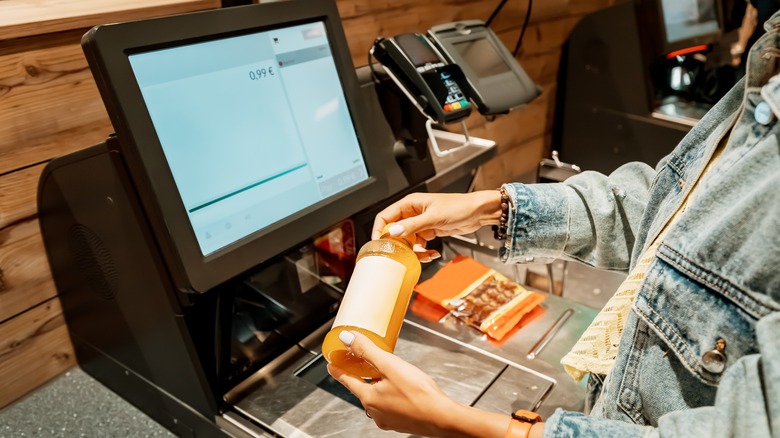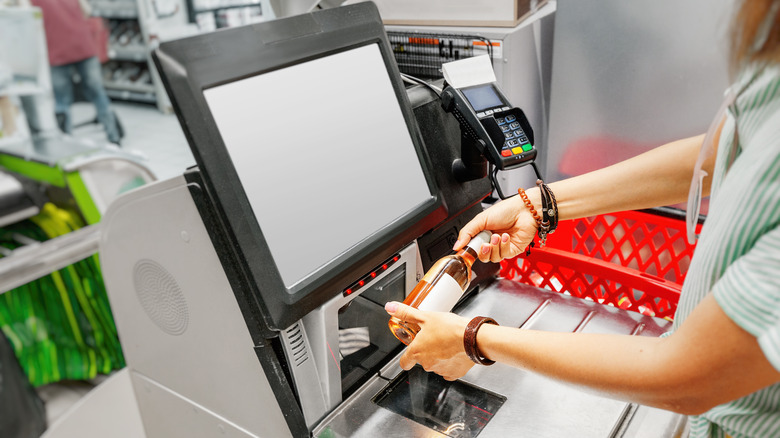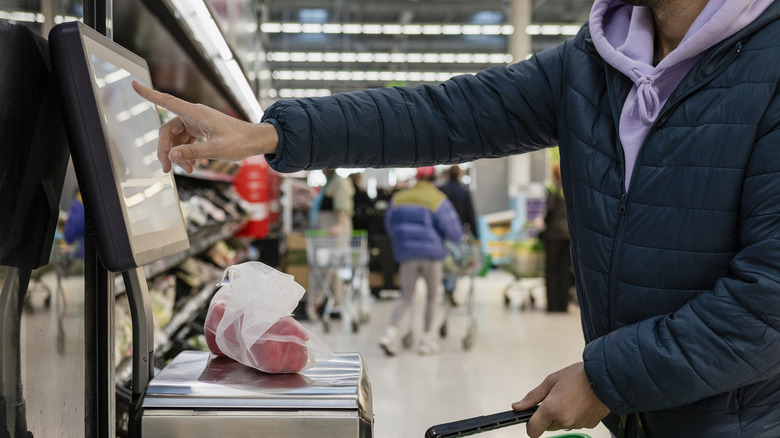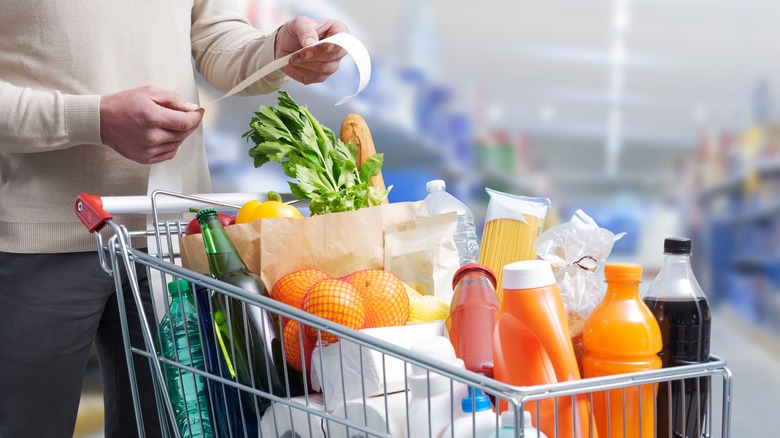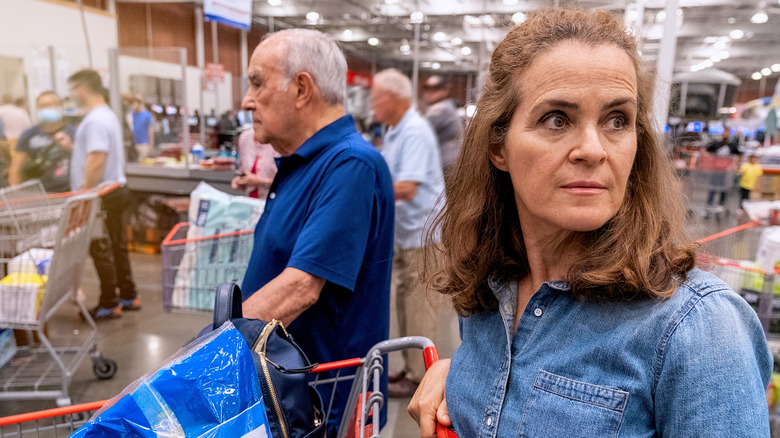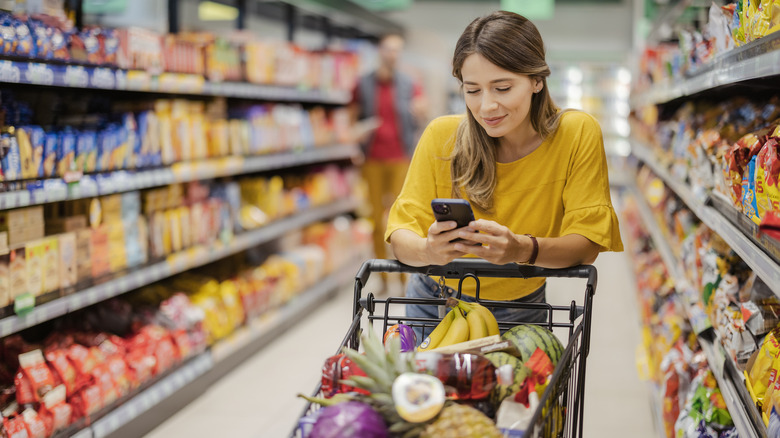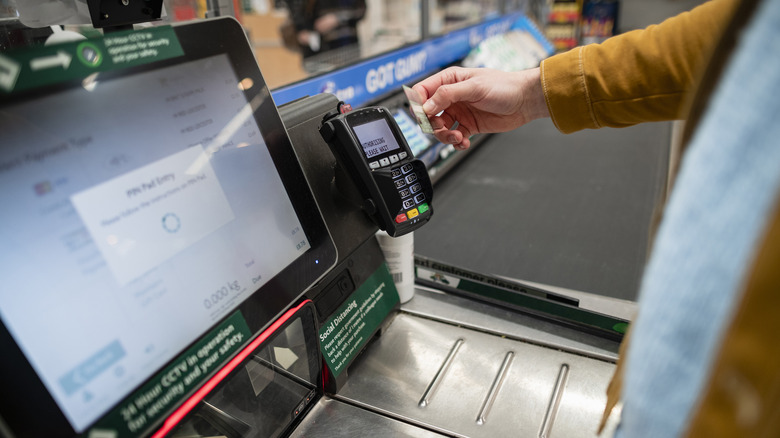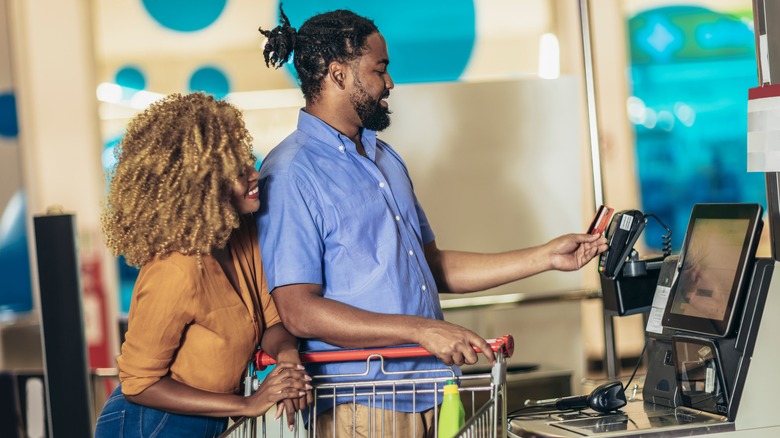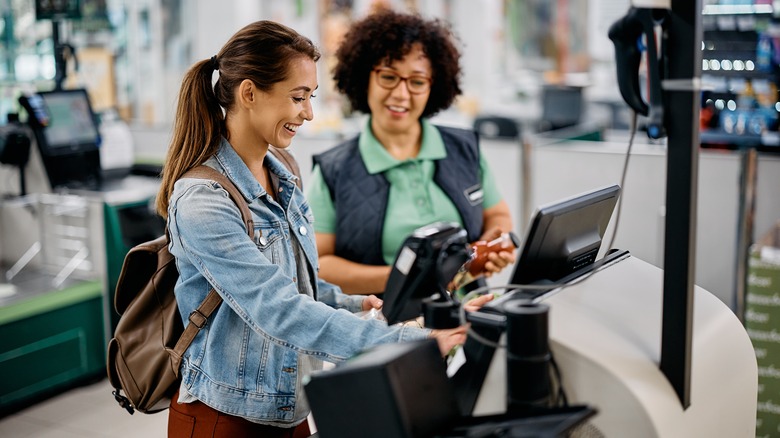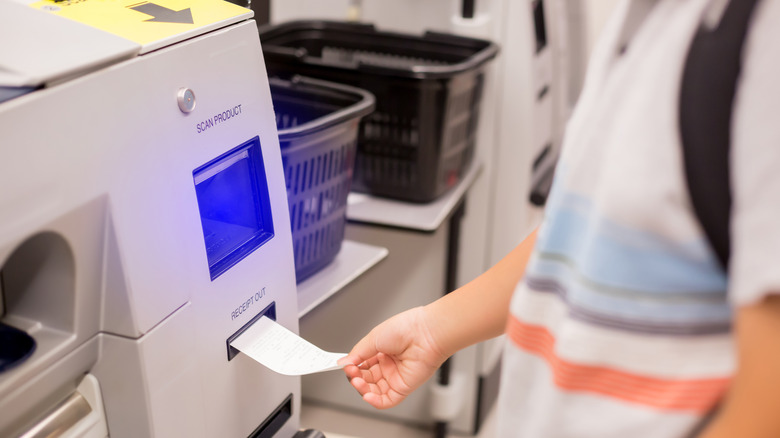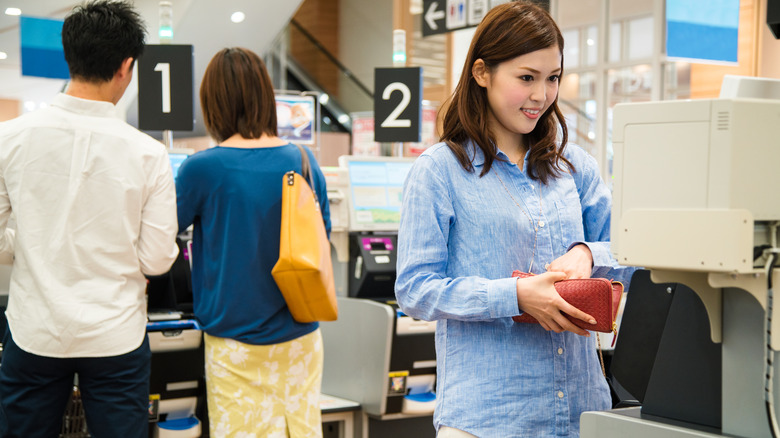11 Rules You're Probably Breaking When Using The Self-Checkout
The self-checkout registers at the grocery store make it possible to quickly scan your items, pay, and get on with the rest of your day. Often, there are only a few staffed registers open at a time, but many stores offer multiple kiosks for customers to complete their purchases on their own, potentially cutting down on that check-out wait time. However, as convenient and time-saving as a self-checkout register may be, you want to be sure to be respectful of the store's staff and your fellow shoppers when using them.
Even if you don't see a set of rules explicitly posted by these kiosks, there actually are several unwritten rules for using the self-checkout. From purchasing age-restricted items, and line etiquette, to how you should leave the kiosk you're probably breaking some of these unwritten rules. But, learning about them and how to avoid breaking them will make things easier for you, the store employees, and your fellow customers.
Not paying for all of your items
This first rule should go without saying, but you should never place any items into a bag or back into your cart that you haven't scanned or paid for. Doing so is stealing. And, beyond being against the law, will threaten the livelihood of the grocery store you're shopping at. In a 2022 report looking at 93 different retailers across the world on the use of self-checkouts, it was revealed that these kiosks were responsible for nearly half of their malicious losses (per ECR Retail Loss). Additionally, two-thirds of the respondents cited self-checkout losses as an increasing problem for their company.
Self-checkout kiosks are for just that — checking yourself out. They should not be seen as a way to take advantage of the company and "accidentally" forget to scan some of the items in your cart. Do your part to support the grocery stores you want to shop at while also being a law-abiding citizen and setting a good example for others.
Purchasing age-restricted products
To prevent minors from being able to purchase products they should not have access to, self-checkout kiosks are designed to alert a sales associate anytime these items are scanned. Before the item can be scanned and before the transaction can be completed, the associate must come over and either scan the individual's driver's license or enter their birthdate to allow them to purchase the item (the exact protocol can vary based on the system and location). Even if you are an adult and able to purchase age-restricted items, it is best to wait in line with a person tending the register. This way, you aren't increasing the wait time for any customers in line behind you while the associate makes his or her way over to the kiosk.
Beer and wine are, clearly, age-restricted products. However, they are not the only items that you can purchase at the grocery store that require ID. For example, there are some age-restricted medications, like DayQuil, that are sold over the counter, and in certain parts of the U.S. some energy drinks are prohibited from being sold to minors. Knowing which items require ID and avoiding buying them at the self-checkout will make things easier for everyone.
Buying produce without knowing the codes
One of the unwritten rules of the self-checkout section of the store is that you should not try to purchase produce — especially not several different fruits and vegetable items. Unlike boxes of cereal, gallons of milk, loaves of bread, and many other grocery store products, most produce items do not have a barcode. This means that you can't simply scan them and will need to either enter the item number or search to find them on the screen.
If you've ever tried to purchase produce at a self-checkout station, then you likely understand why it isn't a good idea. Many times the stickers with the product code are missing, and scrolling through the different categories to find the exact items you want to purchase is time-consuming. If you have a cart full of ingredients for a salad, you can understand how long the process will take to look up each individual item. So, unless you happen to know all the produce codes for what you're purchasing, wait for a cashier who will be able to get you checked out much more quickly while also saving others from waiting in line behind you while you fumble with the machine's search system.
Buying a ton of groceries
One of the big advantages of self-checkouts is that they can help customers complete their purchases more quickly and then get on with everything else they have to do. If you try to check out a huge purchase, you're breaking these unwritten rules by taking too long at the kiosk and holding those waiting in line behind you. When someone is waiting for the self-checkout, they assume they'll only need to wait for a few minutes before the person in front of them finishes up. However, if you have a cart full of products, you are going to take much more time to scan everything. Plus, bagging all of your groceries will add even more time.
Be considerate of other shoppers and use a store cashier when you have a ton of groceries to buy. It will likely end up working out in your favor, too. The cashiers are experienced and much more proficient with scanning items. They will likely take less time than you to search for the bar codes on each item and they won't have to face bagging errors or other problems the self-checkouts inevitably seem to encounter when you have multiple items.
Standing too close to the shopper in front of you
If COVID taught us anything, it is that personal space matters. While social distancing may be becoming an outdated term, it is still something that is important to practice when using the self-checkout. First, if you're standing right on top of the shopper using the self-checkout in front of you then you're going to make them feel uncomfortable. They're going to feel like you are rushing them. This will likely make them feel nervous, which is only going to have the opposite effect and slow them down as they try to figure everything out with the machine. Think about it: Do you want someone breathing down your neck as you're checking out your order?
Remember, customers will also be taking out their wallets to pay for their orders. Respect their privacy when removing cash or credit cards from their wallet. No one wants to worry about anyone taking their cards or viewing their personal information.
Not checking your shopping list
Before you start checking out your order at a self-checkout kiosk, you need to double-check your shopping list against the contents of your cart. Make sure that you've grabbed everything you need from the shelves and that you didn't forget anything. Because what you don't want is to be in the middle of checking out your groceries and realize that you forgot something.
This can lead to two potential problems. The first could be a problem for you. If you finish checking out and pay for the items you have and then go back to grab what you forgot, you'll have to stand in line again to pay for the new item. The other option would create a problem for the shoppers in line behind you. If you decide to pause checking out your order to run and grab the thing you forgot, they'll have to wait in line while you get it. We all know that grocery stores are rather large, so you could potentially be gone for a few minutes trying to find what you need, all the while your fellow shoppers will be waiting for you to return and finish checking out your order.
It's not as annoying to other customers if you forget an item at a register with a dedicated employee because they can always pause your checkout and move on to the next customer. But at a self-checkout, this can't happen!
Using separate payment methods
As you are probably starting to see, a lot of these unwritten rules for self-checkouts come down to respecting the time of the customers in line behind you. This next one is no different. Don't choose the self-checkout line if you want to complete multiple transactions. For example, if you're picking up a few things for work that will be charged on your corporate card, but also need bread, milk, and some other grocery items for your house, it will be best to wait in line for a cashier.
Trying to complete separate orders at a self-checkout station is going to take longer than simply paying for everything at once. You'll have to go through the steps of scanning your club card, waiting for the payment to process, and everything else two (or more) times. If you can't combine your orders together and get reimbursed separately later, just skip the self-checkout.
Not choosing a register that accepts your payment method
Before you begin scanning your items at a self-checkout register, don't forget to check the accepted forms of payment the machine you're using can process. While some kiosks may accept nearly any form of payment, including credit cards, cash, checks, or contactless options, like Apple Pay, others may only accept some of these options.
If you forget to follow this rule and end up at a kiosk that doesn't accept the method of payment you want to use, it can become a big hassle. Firstly, you might need to use a different payment method than you wanted to. But, if you're unable to pay in another way, you'll either need to cancel the entire transaction and move to another register, or you'll end up making more work for the store employees who need to re-enter your entire order and process your payment in a different way. Plus, as all of this is happening, the wait time of the customers in line behind you is going to keep increasing. Fortunately, all of these hassles can be avoided if you take just a few seconds to look for which payment methods are accepted at the self-checkout before you start scanning your items.
Being rude or impatient with the staff
Using a self-checkout kiosk often simplifies the checkout experience. You are in control of scanning your items and processing the payment. However, we all know that technology can be fickle. There will be times when something doesn't go as planned. Perhaps the machine won't register one of the items you're trying to scan. Or, maybe the alert for the bagging area will keep going off, even though you've correctly placed your scanned items where they belong. Other times, the sale price of an item might not come up correctly.
When something goes wrong at the self-checkout machine, the store employees are there to help you. It is essential to make sure you are patient and polite as they're working with you. Whatever issue is going on with the machine is not their fault, and they're not to blame if you're running late to wherever you need to get to. You're also not the only customer in the store, so you might need to wait a few minutes for someone to be available to help you. Keep all of this in mind and make sure you always show respect to the store employees.
Not checking the status of the kiosk before leaving
After you've finished paying for your order, do a quick scan of the kiosk area before walking away. Look for stray grapes that rolled out of the bag, the flaky skin covering the head of garlic or the onion that you purchased, or extra produce bags that inadvertently got left behind. Also, make sure that you take the receipt and any coupons that the machine printed after you've finished checking out. You want to avoid leaving a mess for the other customers or the store employees. Again, this all boils down to being kind and courteous to those around you.
If the kiosk is running short on bags or a notice pops up that the receipt paper is running low, alert one of the employees. This will give them time to restock anything that is out or low before more customers need to use the machines.
Lingering at the register after paying
Even if you're not in a hurry when you decide to go shopping, be considerate of those in line behind you, who probably want to get their products scanned and paid for as quickly as possible. So, avoid lingering near the kiosks after you've checked out your order. This is not the time to strike up a conversation with another customer or an employee about the weather or this weekend's big game.
Work quickly to bag your items, place the bags in your cart or basket, and pay for your order. Once you've accomplished all of these things, move away from the register so that the next person in line can get started on their order. If you want to have a conversation with someone in the store, you can most certainly do so after you've cleared the way for other customers to scan and pay for their items. It's all about being
